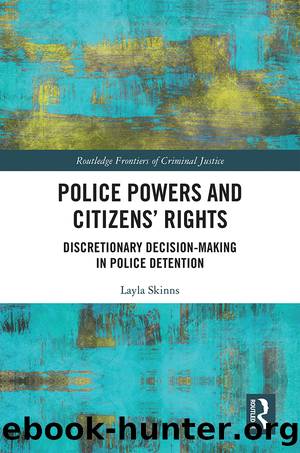Police Powers and Citizens' Rights by Layla Skinns

Author:Layla Skinns [Skinns, Layla]
Language: eng
Format: epub
ISBN: 9780415642309
Barnesnoble:
Goodreads: 42261006
Publisher: Routledge
Published: 2019-02-15T00:00:00+00:00
Notes
1 This is because in the context of globalised worlds in which there is an assumption of cultural convergence, âone can remain sure that as long as cultures, languages, public opinions and social discourses differ, so will criminal justice systems and the way they operateâ (Pakes, 2004: 178, cited in Nelken, 2010: 86).
2 In spite of asking, these police directives were not available at the time of the research, though some of them have since become available online, including directives on adult, child, and intoxicated detainees, but not interviews and interrogations and rights of detainees.
3 This term was used largely in England and without any sense of irony.
4 The other terms in common parlance in the English cities were âDPâ which was short for detained person and sometimes detainee or suspect. In the Australian city, it was also commonplace for the police to refer to detainees as offenders.
5 Those in police custody might occasionally have been remanded or sentenced prisoners, in the English cities in the research. Operation Safeguard, which was ongoing at the time of the research, meant that prisoners were being temporarily held in police cells if the prisons were too full to take them. Similar usage of police detention has also been seen in some parts of Australia, such as in Victoria and New South Wales (Bibby, 2015; Bucci and Willingham, 2013), though this was not the case at the time of the research. Nonetheless, the term âprisonerâ was not reserved solely to refer to this group of detainees, who were being held awaiting transfer to prison.
6 Ink continued to be used up until at least 2007 when automated fingerprint machines were introduced in some police stations. However, ink was still in use in some police stations in 2009, when the present research was conducted, and even up until 2014, in part because the automated fingerprint machines had not been fully rolled out (Garda Inspectorate, 2014: 29).
7 I say most detainees here because some were not eligible for receiving information about their rights and entitlements in police detention. For example, in the Australian city, only those arrested for the investigation of an alleged criminal offence were eligible to receive information about their rights, meaning that those arrested for breach of bail or for a bench warrant were not.
8 Moskos (2008: 125â6) described the booking of an adult and a child arrested for drug dealing, which took 21 forms and labels, which had to be completed in three different places. The lengthy and bureaucratic nature of these procedures meant that officers would often complete them in quiet spells such as between 3am and 7am, so that they were not âout of serviceâ during crucial periods of their shift, which would have earned them a bad reputation.
9 Following Holdaway, police culture is defined here as âthe core of beliefs and values, of associated strategies and tactics relevant to policing, which remain a principle guide for the day-to-day work of the rank-and-file officerâ (1983: 2).
10 By gallows humour, I mean
Download
This site does not store any files on its server. We only index and link to content provided by other sites. Please contact the content providers to delete copyright contents if any and email us, we'll remove relevant links or contents immediately.
The 1921 Tulsa Race Massacre by Chris M. Messer(288)
Introduction to Criminal Justice - A Balanced Approach by Brian K. Payne Willard M. Oliver Nancy E. Marion(255)
Punishing the Poor The Neoliberal Government of Social Insecurity by Unknown(250)
Russia's Sakhalin Penal Colony, 1849â1917 by Andrew A. Gentes(249)
The History of Newgate Prison by Jowett Caroline;(236)
Serial Killers America and UK - 2 BOOKS IN 1 by Clark Matthew(211)
A History of Police and Masculinities, 1700-2010 by David G. Barrie Susan Broomhall(200)
Restorative Justice in Transitional Settings by Kerry Clamp(171)
Organized Crime and Corruption Across Borders by T. Wing Lo Dina Siegel Sharon I Kwok(161)
Culture, Crime and Punishment by Ronald Kramer(156)
Dangerousness, Risk and the Governance of Serious Sexual and Violent Offenders by Karen Harrison(156)
Policing Gender, Class And Family In Britain, 1800-1945 by Linda Mahood(155)
Routledge Handbook on Immigration and Crime by Holly Ventura Miller Anthony Peguero(154)
Cops, Cameras, and Crisis by Michael D. White Aili Malm(154)
The Real CSI by Kate Bendelow(150)
Women Exiting Prison by Bree Carlton Marie Segrave(144)
Using Murder by Philip Jenkins(139)
Losing Legitimacy by Gary Lafree(139)
A Theory of African American Offending by James D. Unnever Shaun L. Gabbidon(136)
